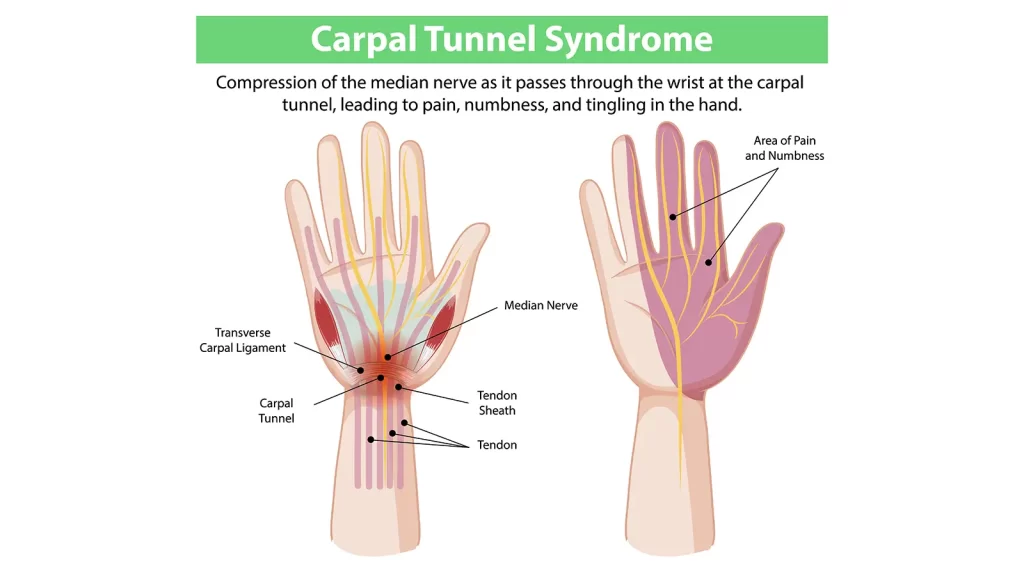By: Dr. Manuel Hernandez y Dr. Omar Guzman
Have you ever felt your hands go numb, especially at night or while using your phone? Do you experience tingling, weakness, or even drop things without meaning to? These could be signs of a common condition known as carpal tunnel syndrome.
What is the carpal tunnel?
The carpal tunnel is a narrow passageway in the wrist formed by bones and ligaments. Running through it are the tendons that help move your fingers and the median nerve, which controls sensation and some motor function in the thumb, index, and middle fingers.
When this nerve becomes compressed — due to inflammation, repetitive hand movements, awkward wrist positions, or even fluid retention — it can lead to carpal tunnel syndrome (CTS), a condition that, if left untreated, can interfere with hand function and daily activities.
Most common symptoms

Carpal tunnel syndrome typically develops gradually and symptoms may come and go at first. However, over time, they can become more frequent and persistent. Common symptoms include:
- Tingling or numbness in the thumb, index, and middle fingers, often worse at night or upon waking.
- Wrist pain that can radiate to the forearm, elbow, or even shoulder.
- Weakness or difficulty gripping objects, opening jars, or using tools.
- Hand clumsiness or accidentally dropping things without a clear cause.
- In advanced cases, muscle wasting at the base of the thumb can occur.
Who is at risk?
While carpal tunnel syndrome can affect anyone, certain people are at higher risk, including:
- Individuals who frequently use their hands for repetitive tasks (e.g., office workers, musicians, hair stylists, seamstresses, carpenters).
- Those with chronic conditions such as diabetes, hypothyroidism, or rheumatoid arthritis.
- Pregnant women, due to hormonal changes and fluid retention that increase pressure within the tunnel.
- People with a family history or genetic predisposition to nerve compression issues.
- Those who maintain awkward wrist positions for extended periods, such as using a smartphone or typing on a keyboard without ergonomic support.
Diagnosis and treatment

Diagnosis is based on a thorough clinical evaluation, where a healthcare provider will review your symptoms and perform physical tests. If needed, additional diagnostic studies such as nerve conduction studies or electromyography (EMG) can help assess the severity of nerve compression.
Treatment options
Treatment depends on the stage of the condition. Early intervention can prevent permanent damage and may include:
- Activity modification to reduce repetitive or aggravating hand movements.
- Wrist splints, especially worn at night to prevent flexion and relieve pressure.
- Stretching and strengthening exercises, guided by a physical therapist.
- Anti-inflammatory medications or corticosteroid injections to reduce swelling.
In more severe cases, or when conservative treatment doesn’t bring relief, a minimally invasive surgical procedure can be performed to release pressure on the median nerve. This procedure often results in significant symptom improvement and restored function.
When to see a doctor
Frequent or persistent numbness in your hands is not normal and shouldn’t be ignored. If you’re experiencing any of the symptoms described, it’s important to consult a specialist as soon as possible. Early diagnosis and treatment can significantly improve outcomes and may help you avoid surgery.
At SINAPTIKON, our board-certified specialists in neurology, orthopedics, and rehabilitation are here to help you restore your hand function and quality of life. Don’t ignore what your body is telling you.
Schedule your appointment today — your hands deserve expert care.









































Leave a Reply